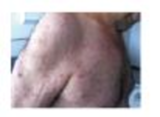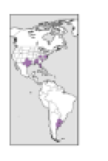
Concept explainers
A New Cause of Spots

Fifty-two-year-old David has a good life. After 30 years serving the country as an Army officer, he has retired to the Texas Gulf Coast-a region of large oaks, mild winter weather, and great outdoor spaces. It’s a great place to retire and enjoy hiking through the woods and meadows photographing wildlife. It would be nearly perfect if some of the wildlife didn't bite. Ubiquitous ants, pesky mosquitoes, and bloodsucking ticks seem to always be on the prowl.
It’s a tick that brings him to his doctor today. The thing had bit him on his left shoulder, resulting in a huge boil that swelled and drained pus, though the lesion doesn’t hurt at all. His primary care physician doesn’t appear to be too concerned and prescribes amoxicillin for the boil.
Three days later, David is back but feeling much worse. He has suddenly developed fever, headache, muscle pains, fatigue, and an alarming rash over most of his body. The physician now suspects Rocky Mountain spotted fever (RMSF), though it’s relatively rare in Texas, and orders a laboratory test using anti-Rickettsia rickettsii antibodies. The test comes back negative; David is not infected with R. rickettsii. He does not have RMSF. The doctor takes a skin sample from the infected area and prescribes 100 mg of doxycycline twice daily for two weeks.

The rash resolves in a week, and further polymerase chain reaction (PCR) testing on bacteria found in the sample of skin reveals R. parkeri. In the United States, the Gulf Coast tick, Amblyomma maculatum, is the vector for this bacterium that was long thought to be harmless to humans. David is one of the first of several dozen patients to tangle with this pathogen that is emerging as a threat in the southeast United States and in Argentina.
- 1. Why didn’t the antibody test show infection?
- 2. What is PCR testing?
- 3. In a
Gram-stained sample of David's skin, what color would the rickettsias be?
Want to see the full answer?
Check out a sample textbook solution
Chapter 19 Solutions
EP MICROBIOLOGY:W/DISEASES BY..-MOD.ACC
- A negligence action was brought by a mother against a hospital on behalf of her minor daughter. It alleged that when the mother was 13 years of age, the hospital negligently transfused her with Rh-positive blood. The mother's Rh-negative blood was incompatible with and sensitized by the Rh-positive blood. The mother discovered her condition 8 years later during a routine blood screening ordered by her healthcare provider in the course of prenatal care. The resulting sensitization of the mother's blood allegedly caused damage to the fetus, resulting in physical defects and premature birth. Did a patient relationship with the transfusing hospital exist?arrow_forward18. Watch this short youtube video about SARS CoV-2 replication. SARS-CoV-2 Life Cycle (Summer 2020) - YouTube.19. What is the name of the receptor that SARS CoV-2 uses to enter cells? Which human cells express this receptor? 20. Name a few of the proteins that the SARS CoV-2 mRNA codes for. 21. What is the role of the golgi apparatus related to SARS CoV-2arrow_forwardState the five functions of Globular Proteins, and give an example of a protein for each function.arrow_forward
- Diagram of check cell under low power and high powerarrow_forwarda couple in which the father has the a blood type and the mother has the o blood type produce an offspring with the o blood type, how does this happen? how could two functionally O parents produce an offspring that has the a blood type?arrow_forwardWhat is the opening indicated by the pointer? (leaf x.s.) stomate guard cell lenticel intercellular space none of thesearrow_forward
- Identify the indicated tissue? (stem x.s.) parenchyma collenchyma sclerenchyma ○ xylem ○ phloem none of thesearrow_forwardWhere did this structure originate from? (Salix branch root) epidermis cortex endodermis pericycle vascular cylinderarrow_forwardIdentify the indicated tissue. (Tilia stem x.s.) parenchyma collenchyma sclerenchyma xylem phloem none of thesearrow_forward
- Identify the indicated structure. (Cucurbita stem l.s.) pit lenticel stomate tendril none of thesearrow_forwardIdentify the specific cell? (Zebrina leaf peel) vessel element sieve element companion cell tracheid guard cell subsidiary cell none of thesearrow_forwardWhat type of cells flank the opening on either side? (leaf x.s.) vessel elements sieve elements companion cells tracheids guard cells none of thesearrow_forward
 Medical Terminology for Health Professions, Spira...Health & NutritionISBN:9781305634350Author:Ann Ehrlich, Carol L. Schroeder, Laura Ehrlich, Katrina A. SchroederPublisher:Cengage Learning
Medical Terminology for Health Professions, Spira...Health & NutritionISBN:9781305634350Author:Ann Ehrlich, Carol L. Schroeder, Laura Ehrlich, Katrina A. SchroederPublisher:Cengage Learning- Understanding Health Insurance: A Guide to Billin...Health & NutritionISBN:9781337679480Author:GREENPublisher:Cengage
 Comprehensive Medical Assisting: Administrative a...NursingISBN:9781305964792Author:Wilburta Q. Lindh, Carol D. Tamparo, Barbara M. Dahl, Julie Morris, Cindy CorreaPublisher:Cengage LearningEssentials Health Info Management Principles/Prac...Health & NutritionISBN:9780357191651Author:BowiePublisher:Cengage
Comprehensive Medical Assisting: Administrative a...NursingISBN:9781305964792Author:Wilburta Q. Lindh, Carol D. Tamparo, Barbara M. Dahl, Julie Morris, Cindy CorreaPublisher:Cengage LearningEssentials Health Info Management Principles/Prac...Health & NutritionISBN:9780357191651Author:BowiePublisher:Cengage





